Drobo Storage Robot. There’s one immutable truth in technology, you can never have enough data storage space. No matter how big that mega hard disk you bought this afternoon, sometime soon you’re going to need to delete stuff to free up space. It’s like death and taxes, right? The problem is getting worse too, as we take advantage of the net to download more music, more video, and take more photos with ever growing megapixel file sizes.
If you’re like me, you’ve probably got a couple of external hard drives doing service as backup and storage areas, hung off USB or Firewire, and you’ve probably upgraded at least a couple of times in the past few years – which is generally not a fun exercise.
With all that in mind, I was pretty excited to hear about a new product called Drobo, which is being billed as the world’s first zero hassle data storage system for PCs and Macs. So excited that I emailed the manufacturer – Data Robotics – to ask for a unit to test out. Well it arrived and I’ve been trying it out for a while and it’s definitely one of the most impressive pieces of technology I’ve seen in a long time.
The basic premise behind Drobo is that users don’t want, or need, complex RAID, NAS or other geek heritage storage solutions. What they really want is a super simple ‘plug in and forget’ disk system which gives them totally safe storage which can be upgraded instantly in seconds. The corporate marketing blurb emphasizes this ease of use over everything. All the high power tech is hidden from view, all the customer sees is a system which protects their data no matter what.
The idea is that you don’t need to understand how to format drives, configure disk arrays, set up partitions or worry about any aspect of the system. Just plug it in and it works. Similarly when you need to add more storage you just unplug a drive and slot in a larger one, or add another disk to a spare slot or whatever. It’s a superb concept and something that has been sorely missing from the market up to now.
First Impressions. Nice box. Sleek black, natty cover, no complicated controls, buttons, ports, geek-i-ness. The kind of peripheral that your granny would love. Drobo ships without any drives, just four slots into which you can install any make, model or capacity of 3.5 inch SATA disk drives. I started with four drives, Western Digital 500GB, 250GB and 80GB units and one Seagate 160GB. A total of 922GB of physical disk space.
The Drobo package includes the device, power supply, USB 2.0 cable, dashboard control software on CD, and a slim but complete manual. The install? Er…unpack, slot in your chosen quantity and capacity of hard disks, insert USB cable into PC and power up the box. Total time? 2 minutes. Install and fire up the Drobo software dashboard program, press OK to format and go make a cup of tea. Five minutes later, all done, no drivers to install, nothing. You now have a shed load of self-configuring, infinitely updateable storage ready to use.
In Use. Well the fascinating thing about reviewing this puppy is that it just works. Not a lot more to say. Once it’s plugged in, all you see on the front panel are some LED lights indicating a) the state of each drive (green is fine, yellow for caution, red means change this drive now), and a set of blue lights which indicate how much overall storage space you have left. Once the whole set of blue lights is lit, you need to add a bigger drive, but before that you will receive indications about storage issues from each of the individual drive lights. It’s just about as failsafe and easy to use an interface as you can get.
The dashboard software also provides more detailed information and sits in your tray (if you’re a Windows user). You can access it at any time to see the state of play of how much space is being used, get diagnostic information, shutdown the system and such-like.
Noise. The one thing you will notice if you’re used to a quiet environment, is the noise. It’s not huge, but you can definitely hear the big fan whirring on the back of the unit at intermittent times, and the spool up of the drives under load can be quite disconcerting. But the unit does go into a silent ‘fan off’ mode when there’s been no action for some 15 minutes, which means that the noise never really becomes a big problem. However if you are using the unit in a home recording studio set up, you may want to stick it away behind glass somewhere so you can still see the lights, but not suffer any unwanted sound effects on your recording. I wouldn’t be surprised to see the company continue to improve this area as time goes by.
Use and capacities vs RAID. The Drobo system is not RAID, it’s a proprietary technology, which brings with it quite a few advantages. The first is that you can mix and match any type of 3.5″ SATA drives, and you will be able to take advantage of a significant amount of the total storage available. With RAID your capacity is limited by the smallest drive in the array, with Drobo the total capacity is pooled together, a chunk is set aside for ‘expansion’, another chunk is used for ‘protection’ and what’s left is yours to use.
In my setup, out of the 922GB of physical space some 451GB was available, so I lost around half. There’s a handy calculator called the Drobolator on the Drobo site which lets you determine the optimum disk array to use to obtain your desired storage, which is very useful. Despite the fact that you lose a fair amount of disk capacity, you have to remember that this is replicated capacity, it’s double protected in case of drive failure, which is a key point about the whole setup. A drive goes down? No problem.
With RAID you also have to have the same drive sizes, you can’t mix and match like Drobo. And probably the most important difference between the two technologies is the fact that you can still keep using a Drobo unit even if a drive fails or you need to upgrade. You don’t need to wait for a rebuild or re-layout process to finish before you can carry on. It’s a huge time-saver in an emergency. You also don’t need to go through any kind of formatting when you insert a new drive, you only need to do the one format when you first install the system with the starter drive/s.
Technology. The technology used is a clever combination of disk striping, mirroring and parity, and the system uses smart-tech to adapt the storage space and secure backup of your data on the fly, depending on the number and capacities of the drives you’re using. There’s nothing revolutionary about the tech, it’s just that the developers seem to have put it all together in a rather intelligent way. From an operational point of view it means that you can swap disks out instantly, drive failures become irrelevant (as long as you’ve still got enough space for the ‘protected’ data of course) and you can upgrade your drives as you go without having to go through any complicated copying process or downtime while the new drive is recognised by the system. In practice you can literally slot the new larger drive in while you’re in the middle of copying files across from your computer to the Drobo unit. It’s really impressive. This marketing video gives a great demonstration of the power you get from this flexible architecture.
Robustness. It’s all about redundancy baby. It’s all well and good talking about it, and watching company videos, but how is it in practice? Well I had a good go at breaking the device. To simulate a drive failure I unplugged the largest 500GB drive and then immediately started copying across 75GB of data to Drobo while it was re-configuring itself to cope with the loss. There was no hiccup at all. The files started transferring across, albeit very slowly (127 minutes to completion) and the system blinked red/green to me for around 40 minutes while the rebuild occurred, after which all the lights turned green and the files continued to be transferred. I then slotted the 500 GB back in to see what would happen, and it carried on regardless. No problem, no glitches. Wondrous!
I did, however, manage to hang my laptop during all this by deciding to be a real pig. I asked the dashboard to conduct a diagnostic routine (which has to be pretty low level right?) while the 75 gigs were still in transit and Drobo was busy assimilating the re-inserted 500GB drive. Not a total hang (the caps lock light still worked) but everything else on the PC stopped functioning. I then had to do a full power down, unplug the power to Drobo, and restart everything to get back to normal. Result? Drobo had successfully completed the transfer of the largest 63GB file and elegantly stopped the transfer of the rest of the files during the power down. I just re-selected the remainder of the files and continued on with the transfer with no hassles whatsoever. Now that’s robust!
Target market. I talked with Mary Hwang, director of product marketing for Data Robotics, and she said that the original target market was anyone who dealt with large quantities of files – musicians, photographers and the like. “We have users editing HD video, as well as professional photographers and musicians using Drobo for archiving and backup!”, she confirmed, “Before Drobo many of them were having to struggle with managing a number of different drive systems. We’re about 50/50 PC and Mac users and we span the range from cool creative types to alpha geeks. In fact 20% of our users have Linux running on their primary computer.”
Constraints. Of course there are bound to be trade-offs with something designed to be as user friendly as this. First off is speed. Most people won’t notice the slight drop off in access speeds, but anyone needing hyper fast drive response all the time should probably look elsewhere. The spool up time on four drives can take several seconds from the dormant state, which could get annoying for some people. Likewise the noise could be a factor, as mentioned before.
One other issue to think about is the limitation to a particular type and format of drive. Right now 3.5″ SATA drives are plentiful and well priced, but at some point in the future they will be replaced by smaller, different tech formats, which will make this generation of Drobo redundant. It’s not a real issue of course, because that’s the nature of progress, but it’s something to remember and watch out for. No doubt by the time we’ve all moved on to 2.5 inch drives as standard there’ll be a Drobo X product on the shelves ready and waiting. Finally there is definitely a price premium involved here. In the US the product sells for $499.00 before you add any drives (in the UK it’s £349.00) so it’s a fairly steep investment to make. But if you plan on doing a lot of photography, music storage or the like, then this it clearly a great way to future proof your data, especially since you can start with small capacity low cost hard disks, and add larger units as they come down in price.
Conclusion. I started by saying that Drobo is one of the most impressive and exciting technologies I’ve seen for a long time, and close up exposure to the device has confirmed my initial expectations. It’s a well thought out, super clever piece of technology which hits the sweet spot of prosumer data storage needs at exactly the right moment. The ability to upgrade instantly on the fly, combined with the glorious luxury of zero-hassle data mirroring means that this is really the only storage anyone should need to stay safe and happy. In fact the only thing I can think of that would be better is to have two of the things, one box on-site and one off-site. Which of course marks me out as totally paranoid, but hey, the 4GB of photos of me in a green striped Mankini are priceless, all right?
Drobo Specifications
* Four Bay Disk Interface – 3.5″ SATA I or SATA II hard disk drives, full or half-height, no carriers required. Choose the drive manufacturer, capacity (mixed capacities ok), and spindle speed or cache that fits your current storage needs
* Capacity – continuously upgradeable with larger and faster drives.
* Host Interface – High Speed USB 2.0
* Max Sustained Transfer Rate – Up to read 22MB/s write 20MB/s
* Size – Inches : 6.3 (w) 6.3 (h) 10.7 (l). Milimetres: 152.4 160.02 271.78
* Power – Idle system (standby, drives off) = 5 watts
Typical idle system – idle, drive spin down mode (one drive) = 12 watts
Typical busy system (four drives) = 40 watts
Input – 100-240V AC, 50/60 Hz
Price $499.00/£349.00
Fully automated storage you don’t have to manage. As rich media (photos, video, movies, music) continues to devour your storage capacity, you need a solution that allows you to easily manage, protect, and scale storage for your PC or Mac. For you, we’ve created Drobo, the first fully-automated storage robot to take the pain out of keeping your important digital content safe.
Continue Reading… 1 2 3 4 [View All]

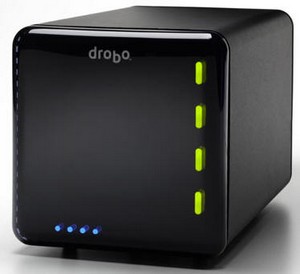
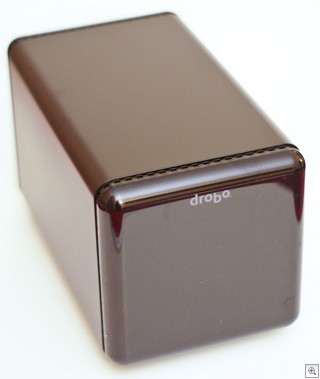
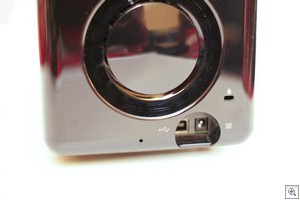
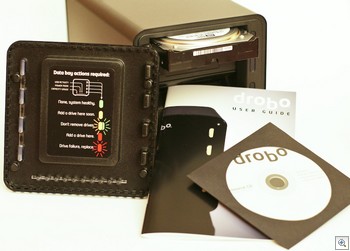
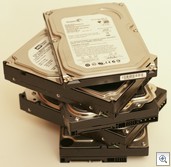
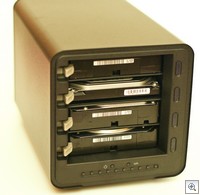
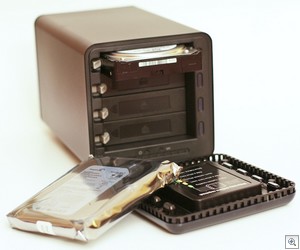
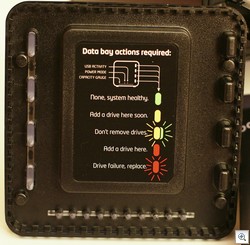
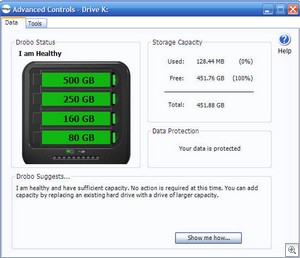
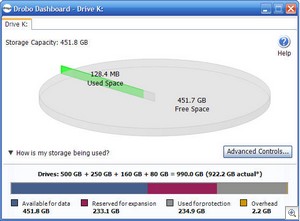
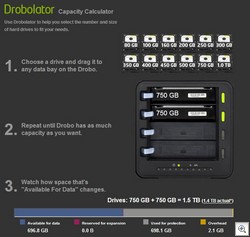
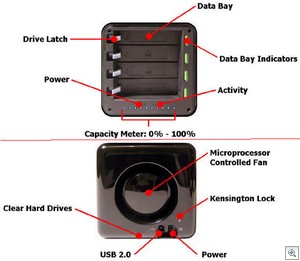
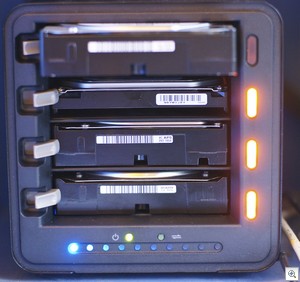
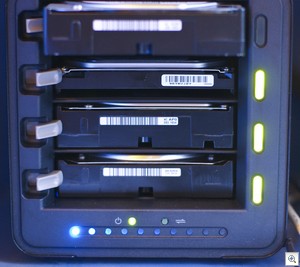
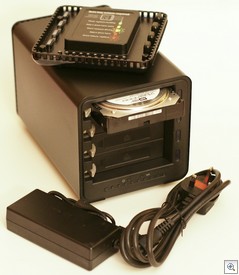
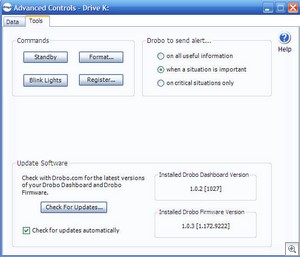

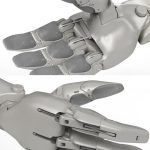

Very nice, but really only suitable for home users. Corect me if I am wrong but I could not not see any options for RAID, which is very important in terms of speed and redundancy for business.
On top of that capacity is quite small in my opinion.
Paul, the whole point of this box is redundancy but done more efficiently than RAID. The capacity is determined by the size of the disks you use, so if you have 4 x 1TB drives in the slots you will get 2.7 TB of useable space (the rest being for the mirroring of the data etc). See this forum post for more information.
Dang that’s pretty nifty, I’ve been looking for something similar for our place. The only problem I see is that’s only has a USB interface and can only be used if the PC is connected. I wonder if they’ll do a NAS version?
Although the laptop hang that you had seems to indicate that it will kick on regardless of whether a PC is attached or not, you just need the PC to access the files.
Red,
Thanks for your comment.
I do realise that the whole point of the box is redundancy, but my point was that having no option to change the RAID type is not great.
For example, some people may want to do striping as well as mirroring, or RAID 0+1 (see http://www.acnc.com/04_01_0_1.html ) . As it is , this product cannot do that as 5 discs would be required for this setup.
In addition, a network connection ideally gigabit , would have been nice. I see from the spec that it is USB…
I have a feeling that Drobo is designed for people who don’t want to worry about RAID configurations and just want a simple backup/storage device, Paul. Different target markets? :-)
Hi Red,
Yeah I do agree that it is designed for a different target market. But still it would have been nice for the manufactor to include a basic interface as well as an expert interface for the clients that would want this functionality.
Have you also heard of a free open source solution for people who would like to make their own NAS (provided they have a spare computer and a few hard drives)
Here is one : http://www.freenas.org/
Now that is one great machine! I loved the thing. But tis a tad bit too expensive for me. Les c what happens in the near future.
Get the DROBO Share if you want to use it as NAS. You are not limited to USB or FW-A.